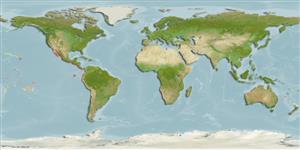>
Beloniformes (Needle fishes) >
Hemiramphidae (Halfbeaks)
Etymology: Hyporhamphus: Greek, hypo = under + Greek, rhamphos = beak, bill (Ref. 45335); naos: Named for the Naos Island, Bay of Panama, where the species is common and the site ot the Smithsonian Tropical Research Institute (STRI) Marine Laboratory..
Environment: milieu / climate zone / depth range / distribution range
Écologie
marin; saumâtre; profondeur 0 - ? m. Tropical
Eastern Pacific: from Baja California, with strays north to San Diego, CA, south to Paita, Peru and in the Galapagos Islands.
Taille / Poids / Âge
Maturity: Lm ? range ? - ? cm
Max length : 29.0 cm SL mâle / non sexé; (Ref. 96012); poids max. publié: 74.50 g (Ref. 96012)
Description synthétique
Clés d'identification | Morphologie | Morphométrie
Rayons mous dorsaux (Total) : 12 - 16. This species is distinguished by the following characters: dorsal and anal fin bases of adults are covered with scales; first gill arch rakers total 29-39, second gill arch rakers total 21-28; pelvic to caudal extension falls anterior to opercle and posterior to upper jaw; for continental population, pelvic to caudal distance usually 0.44-0.47 to SL; preorbital length to orbital diameter usually greater than 0.70 (in 81% of 119 specimens examined) (Ref. 42105).
Inhabits inshore, coastal and estuarine; found along sand beaches, in lower tidal streams and mangroves. Usually encountered in schools at the surface of the water (ref. 42105).
Life cycle and mating behavior
Maturities | Reproduction | Spawnings | Egg(s) | Fecundities | Larves
Banford, H.M. and B.B. Collette, 2001. A new species of halfbeak, Hyporhamphus naos (Beloniformes: Hemiramphidae), from the tropical eastern Pacific. Rev. Biol. Trop. 49(1):39-49. (Ref. 42105)
Statut dans la liste rouge de l'IUCN (Ref. 130435)
Menace pour l'homme
Harmless
Utilisations par l'homme
Outils
Articles particuliers
Télécharger en XML
Sources Internet
Estimates based on models
Phylogenetic diversity index (Ref.
82804): PD
50 = 0.5000 [Uniqueness, from 0.5 = low to 2.0 = high].
Bayesian length-weight: a=0.00245 (0.00134 - 0.00449), b=3.11 (2.96 - 3.26), in cm total length, based on LWR estimates for this species & Genus-body shape (Ref.
93245).
Niveau trophique (Ref.
69278): 3.0 ±0.4 se; based on size and trophs of closest relatives
Résilience (Ref.
120179): Haut, temps minimum de doublement de population inférieur à 15 mois (Preliminary K or Fecundity.).
Fishing Vulnerability (Ref.
59153): Low to moderate vulnerability (25 of 100).
